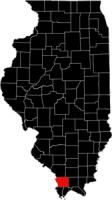Union County

Location of Union County in Illinois.

Location of Union County in Illinois.
This two-piece pottery grave marker was made for Nathaniel Kirkpatrick, a member of the family that owned Anna Pottery in Anna, Illinois. Ceramic is a not a common material used for grave markers, and this piece is particularly unusual in that it was created more to show the virtuosity and invention of the potters than to make a marker to last for eternity. Two popular motifs of 19th century grave markers were used: the urn and the tree trunk.
The urn harks back to ancient Greek funeral cremation urns. The interest in Greece and Rome—the Neo-Classical Revivals of the 18th and 19th centuries—inspired architecture and decoration that emulated these ancient cultures. The urn also suggests two literary passages: "ashes to ashes, dust to dust" from the Book of Common Prayer; and Keat's famous Ode to a Grecian Urn: "What leaf-fring'd legend haunts about thy shape / of deities or mortals, or of both."
A tree trunk or stump also represents death—a life cut down, often in its prime. Stonemasons carved limestone cemetery stones in the shape of tree trunks during the War Between the States for the graves of soldiers killed in battle.